- The Moving Wall |
- Handbook of Information
Handbook of Information
Handbook of Information will be very helpful for those communities and organizations that want to have The Moving Wall™ visit their area.
Download This Page as a PDF
Preparation and Logistics
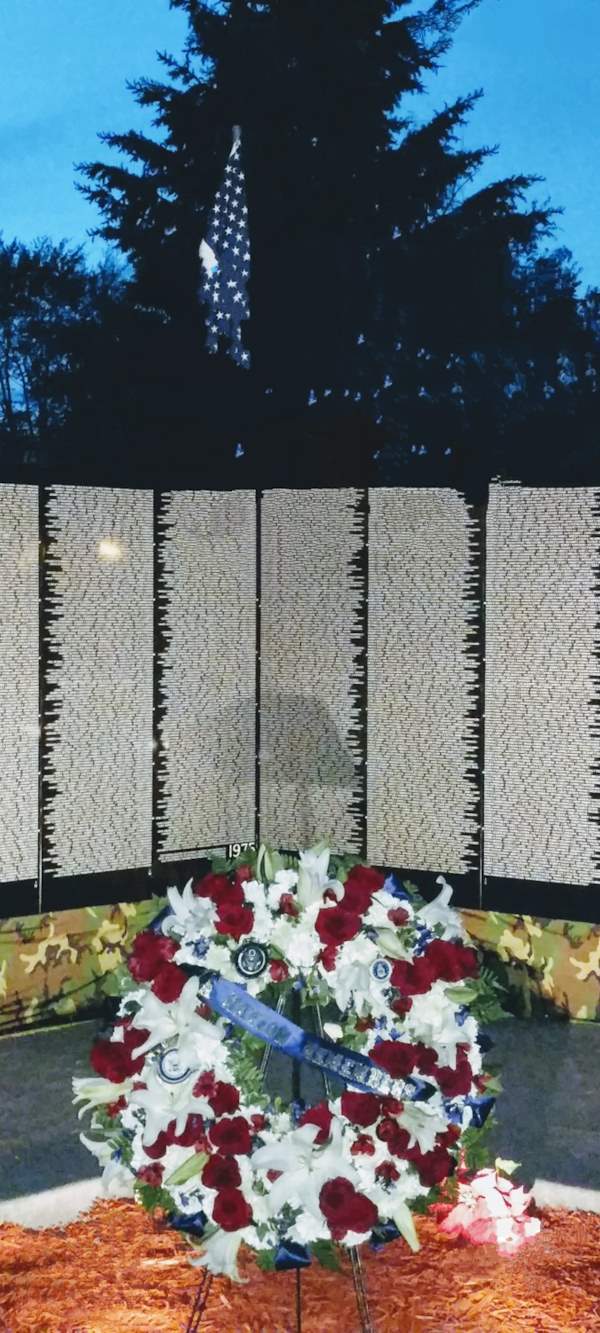
Honor and Respect
It is important to maintain a dignified and respectful mood at The Moving Wall™. This means staying in control of whom and what is going on at the Wall. Don't be afraid to tell some people no. Unfortunately, an event like this brings out some who would like to perform acts that are contradictory with the purpose of The Moving Wall™. This includes those who want to publicize themselves, sell items, or promote their own causes and projects. Fortunately, they are few. Regardless of what some will claim to you, NO ONE is allowed to sell anything at The Moving Wall™. Please be aware that there are NO vendors who are associated with The Moving Wall project. Likewise, no entertainment is allowed to take place at The Moving Wall™.
The Moving Wall™ was years ahead of other traveling memorials that cropped up long after the years and months of designing and testing various materials, and long after The Moving Wall™ had proven its agenda as it toured the country. The Moving Wall™ is the only replica of the Vietnam Veterans Memorial. Other traveling memorials are simply replicas of The Moving Wall™. The Moving Wall™ remains the only one that is maintained by the same Vietnam veterans who silk-screened the first name onto the first panel at the beginning of 1983. You are displaying some powerful art created with love by Vietnam veterans and their friends.
Like your own reason for wanting to bring it to your community, The Moving Wall™ was constructed for the sole purpose of SHARING.
Publicity
Let the people in the community, and the surrounding area, know you are and are bringing The Moving Wall™ to your community to Honor and Respect those that made the ultimate sacrifice through Remembrance and Education. By bringing The Moving Wall into your community, you are giving many people an opportunity they would never otherwise have.
There are so many media sources available today, (television, newspapers, internet, posters, flyers, etc.), that as many as possible should be utilized. It is heartbreaking when someone that will never make it to Washington, D.C., is not informed that The Moving Wall™ is in his or her community.
One person should be designated as the liaison between the sponsor and the media. This will eliminate people giving inaccurate or conflicting information to the media. This one spokesperson can then direct the media to the appropriate person they may interview, for particular aspects of the project. Billboards can many times be "borrowed" for a month or two, before the event dates. Newspapers, TV and Radio/Blog opportunities are there for the asking. Remember, they're looking for stories too.
When distributing media packets, it is important to clearly state who the sponsor is, your reasons for bringing The Moving Wall™, and a clear and accurate description of The Moving Wall™, including a brief history covering by whom it was built, and why. It is an extremely important story and many times it has been overlooked. People should never walk away from The Moving Wall™ with the idea that the government paid for this project, or some corporation funded it. The story is important, not to glorify any individuals, but to demonstrate the spirit and commitment that are an integral part of being American.
Site Selection
A grassy, park-like area with trees, if possible, makes an appropriate setting for The Moving Wall™. Besides being aesthetically pleasing, a park-like setting is more conducive to tranquility and contemplation. The sturdy and straight platform itself needs to set on a level plane. The structure will not be set up on an improperly built platform. It is braced with supports that need to be staked into the ground approximately 18 inches. For this reason, The Moving Wall may not be set up indoors. A location on concrete or asphalt will require drilling seventy-six one inch holes during set up, this is in addition to securing the level base prior to The Moving Wall’s™ arrival.
See the section Assembly / Disassembly for further information on site preparation.
Landscaping
Many previous sponsors have had landscape designers, florists, etc. help with lining each end of The Moving Wall™ with shrubs, small trees, and flowers. The majority of these services and plants have been donated for the duration of The Moving Wall's™ display. It truly adds to the beauty and simplicity of The Moving Wall™. Nothing should be placed where it will rub against The Moving Wall™.
Tents and Shelters
It is suggested that arrangements be made to have a large tent or canopy at the site main entrance. This can be used for the main command post and information center. A canopy, or tent with the sides rolled up (weather permitting) is more inviting to visitors to approach for information. This can be a project that you may choose to invite a corporation, or perhaps a military unit, to donate the use of a canopy or tent in order to minimize your expenses. It is a good idea to have some type of shelter available in the event of bad weather.
When deciding where to place the tent, keep in mind that a large tent can easily block the view when taking photos of The Moving Wall™.
A heater should be provided if the evenings are likely to be cool. Tables and chairs for the volunteers, with a few additional chairs for visitors, should be available.
Assembly / Disassembly of The Moving Wall™
The minimum number of helpers should be ten. However, if you have ten or more people who have volunteered and more people show up and want to help, do not turn them away for fear of too many. Devitt's concept was to make this a "community project," letting people do whatever they could as their contribution to the project.
It takes approximately three hours to assemble The Moving Wall™, when it arrives onsite. Because of the vast number of people who have handled the panels, and the vast number who will handle them after it leaves your community, great care should be given in handling each item. While some people think that a panel is light enough for them to carry by themselves, we want two people to carry each panel. Besides making it easier for some, the main reason is to make certain that a panel isn't dropped or hit against something while carrying it. The slower the helpers work, the greater attention to detail and care they will give, thereby assuring that The Moving Wall will look as fine as it should when erected. All workers will be briefed by The Moving Wall™ personnel prior to handling and assembling. Tools used in assembling the structure are brought with The Moving Wall™.
Prior to The Moving Wall’s™ arrival, it will be necessary to build a simple, level foundation of 2 x 4 lumber for The Moving Wall™ to set on. The Moving Wall™ foundation will be a V shape. The angle can be from 90° to 125° in order to make the structure fit in your location. The length of each end of The Wall is 126.5 ft.. The foundation can consist of 2 x 4 posts driven into the ground every four feet, with enough excess to allow cutting the tops off to provide a level base (2x4x8') to be screwed to them. This is where The Wall will set. When building the foundation, you want to keep the structure as close to the ground as possible. However, there are times when it may be up to two feet above the ground in places if that is what it takes to maintain a level platform. It must be sturdy and not wobble. We bring a cloth material with The Moving Wall™ to drape over the foundation so the platform itself is not visible from the front.
It is advantageous to have the same individuals who helped set it up should perform disassembly of The Moving Wall™, if possible. Disassembly takes about an hour and a half.
Pictures of various foundations
Goal - Perfectly Level Solid Foundation for Wall Panels to be placed Upom
As you will quickly notice, each location is different. As a result of that, each "foundation" will be designed/structured a little differently. However, the end result is the same - The Foundation must be perfectly level and solid to support not only the weight of the panels, but it allows them to be secured to the earth to keep them aligned, level, upright and looking just perfect at YOUR Location.
The public side of the wall when assembled and ready to be viewed should be as level as possible with a smooth type surface for the general public to easily walk and view the wall. It needs to be a surface that a wheel chair and or walker can be navigated easily also.
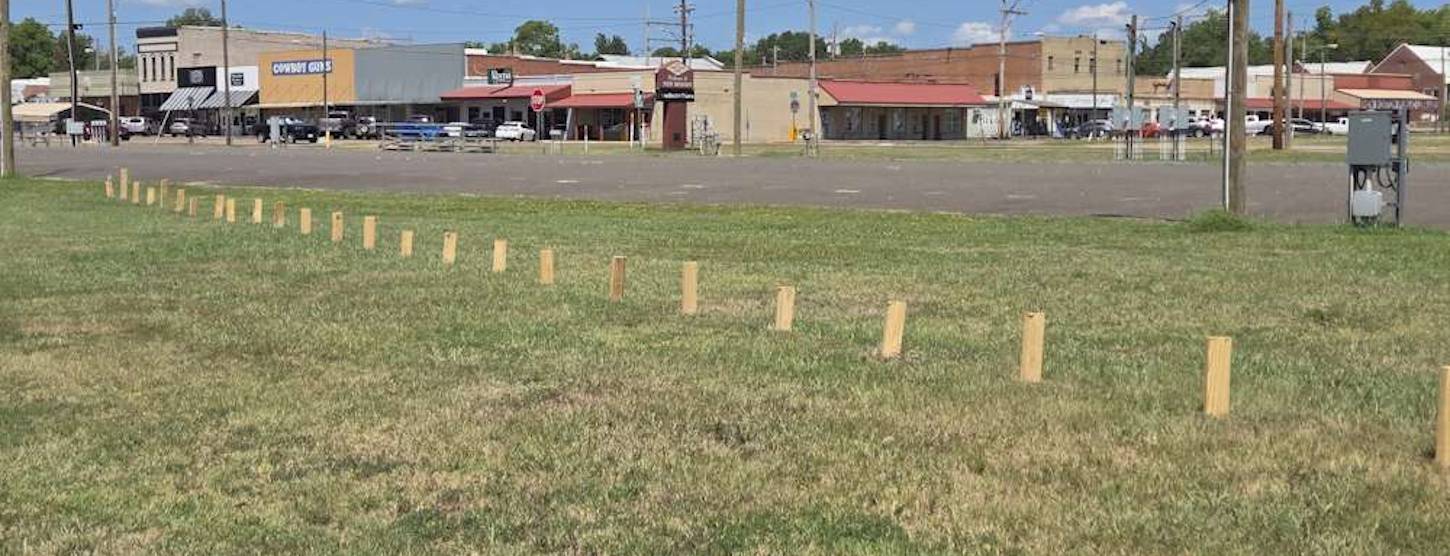
2x4's pounded into earth every 4 ft

2x4's leveled and cut to create a "flat" surface for the Wall channel for the panels

What it should like when completed - waiting for arrival of wall channel & panels
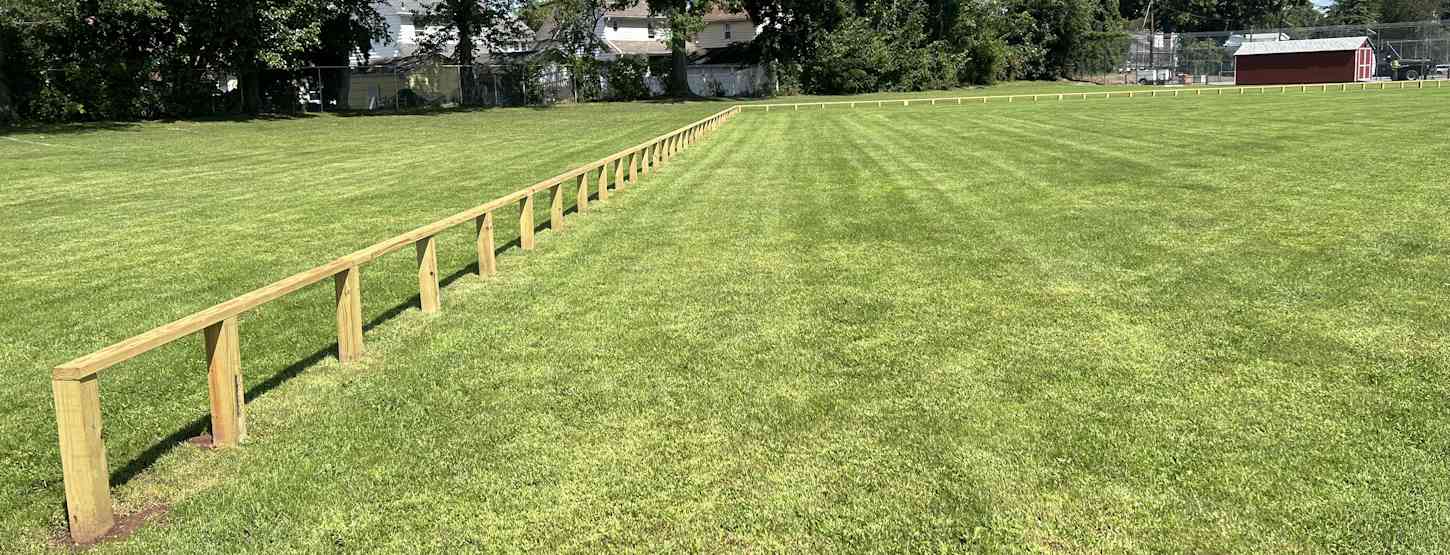
What it should like when completed - waiting for arrival of wall channel & panels
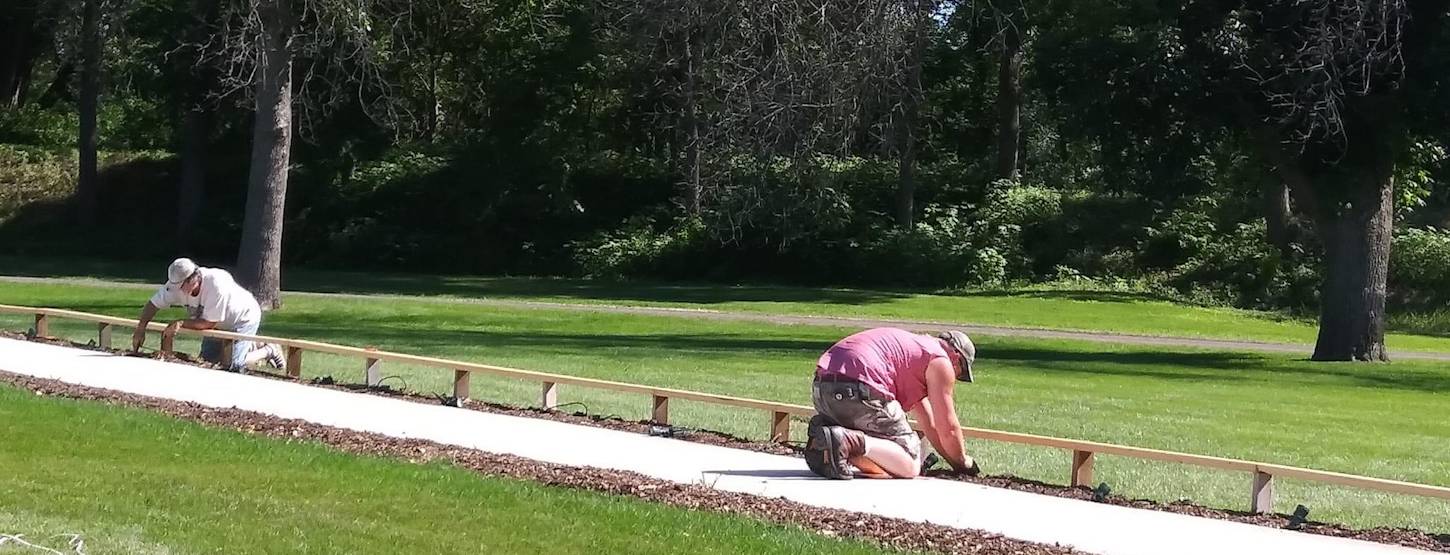
What it should like when completed - waiting for arrival of wall channel & panels
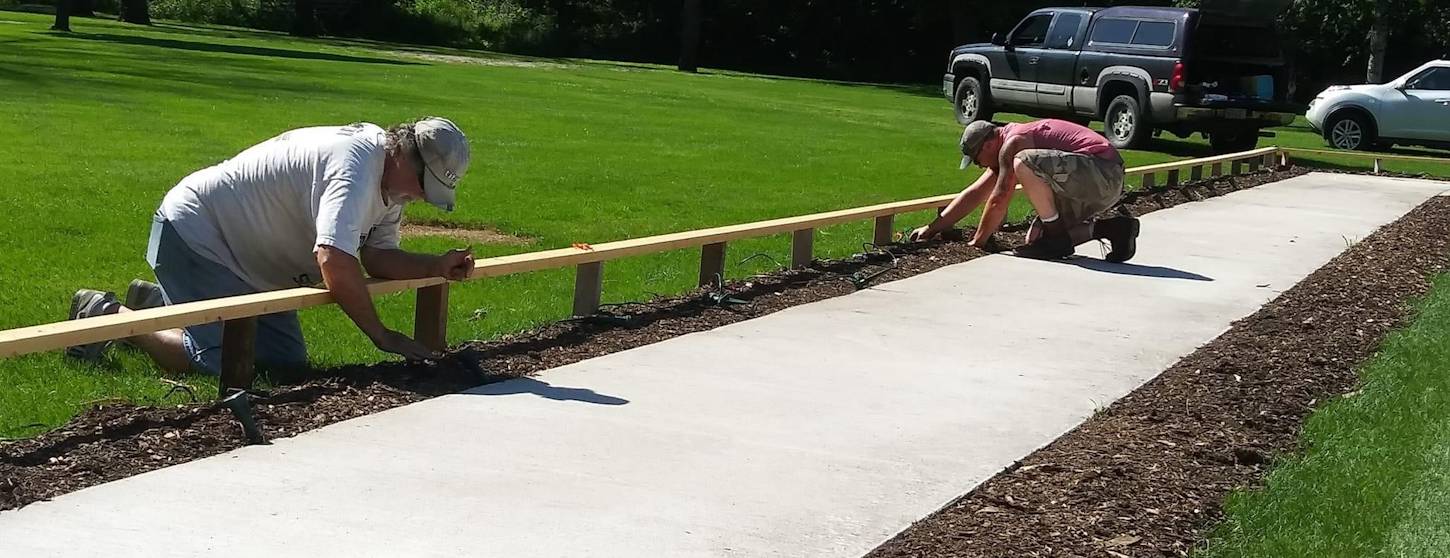
What it should like when completed - waiting for arrival of wall channel & panels
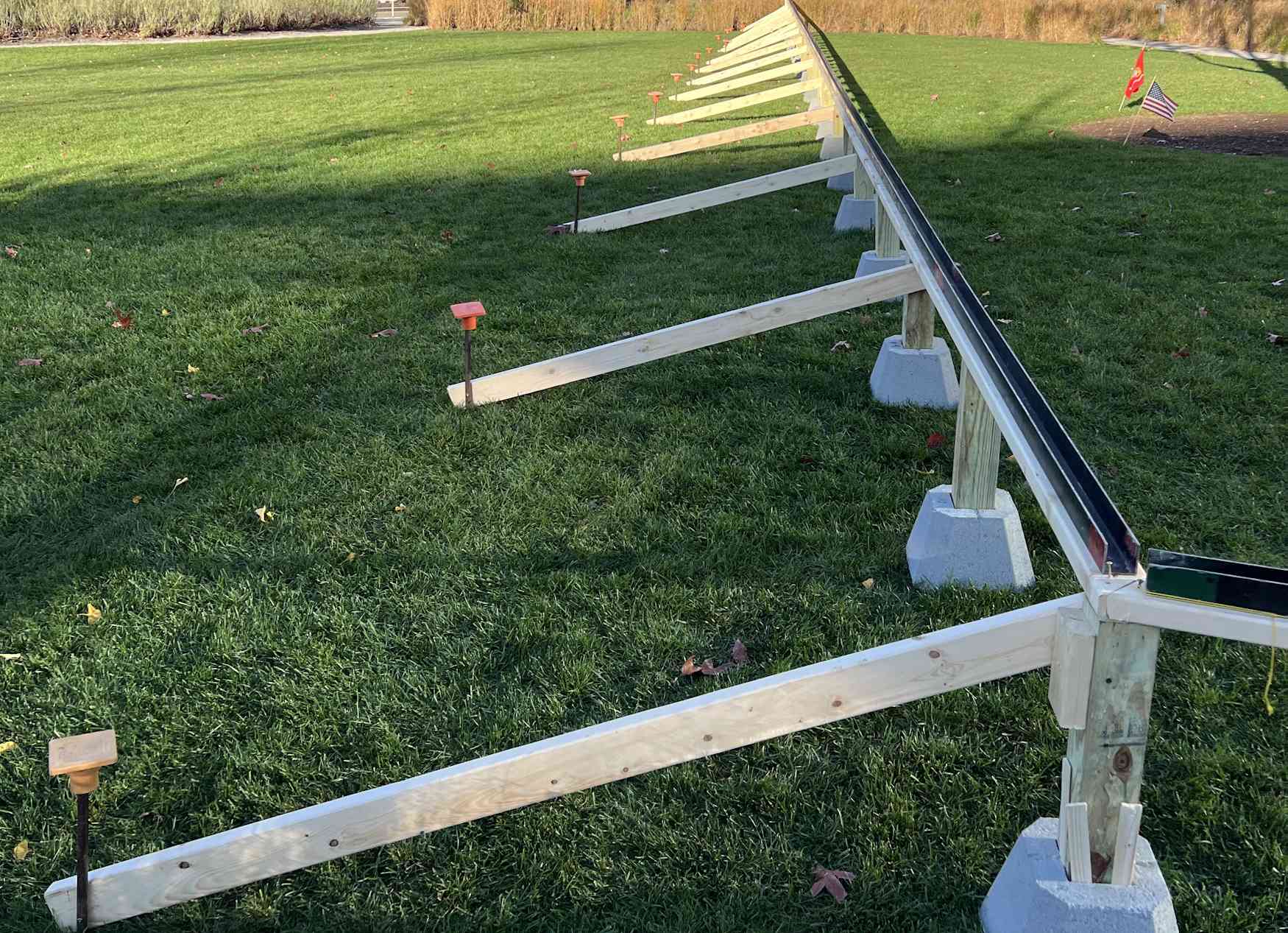
Foundation ready. The Moving Wall Vehicle has arrived and the iron channel is installed for the panels to rest in.
Once channel is finished, camouflage cloth is placed over entire foundation for the panels to be erected.
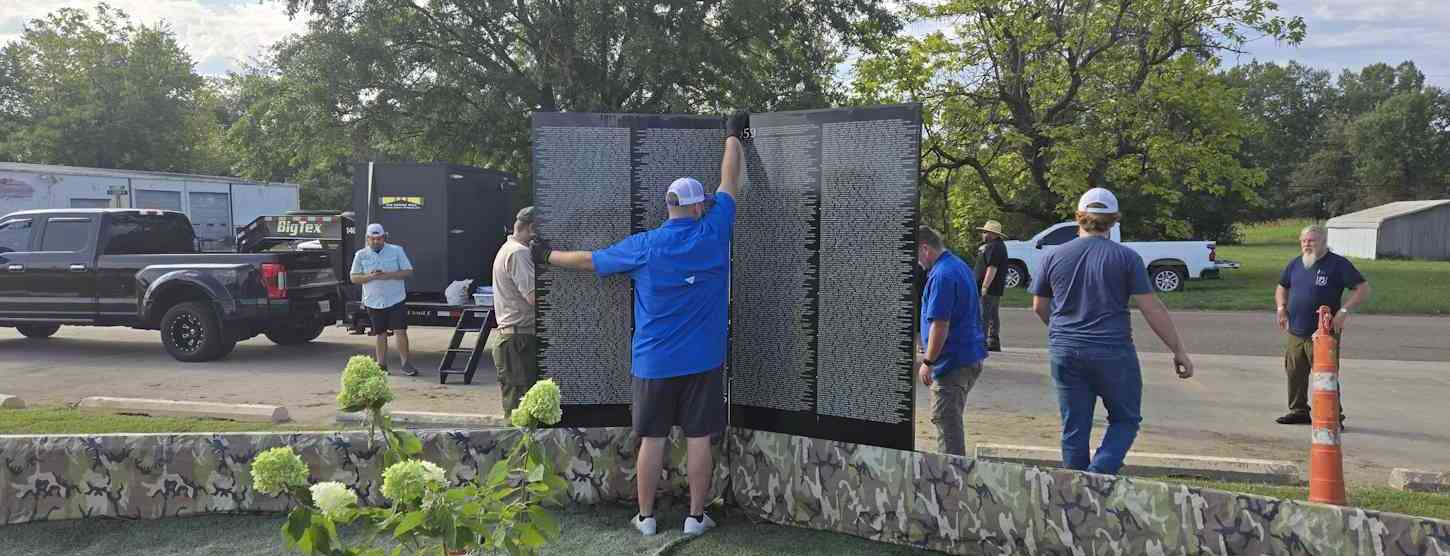
Foundation ready. Installation starts at the center apex - public side view
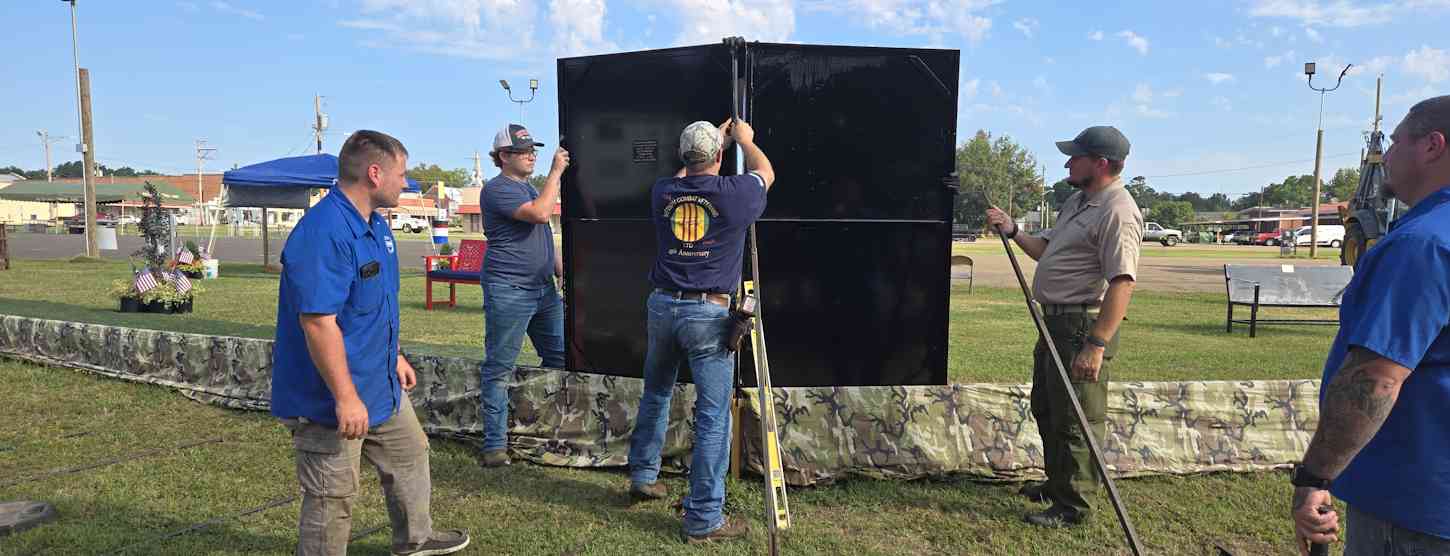
Behind view of actual installation of the wall.
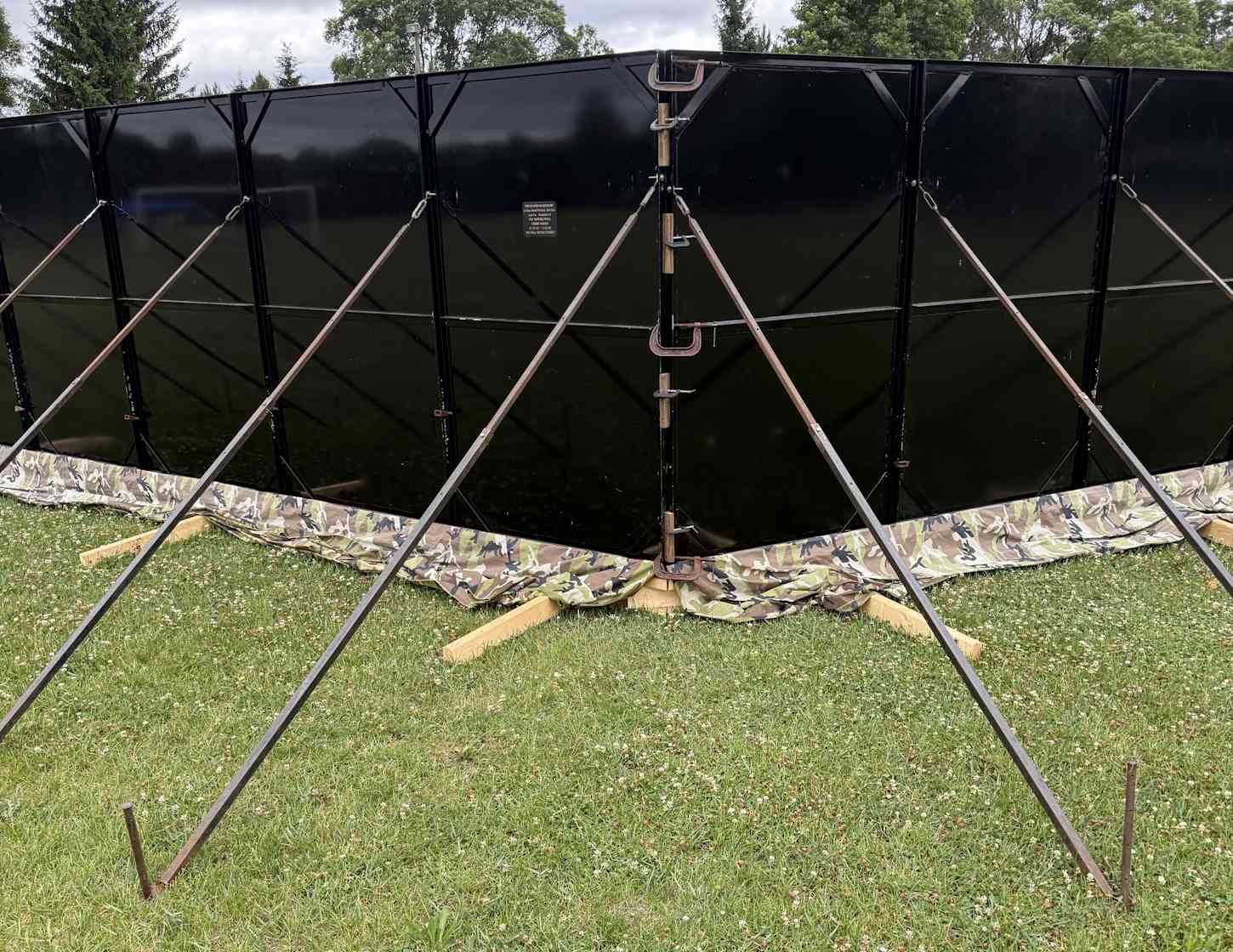
How the wall is installed along the foundation and supported to maintain its image.
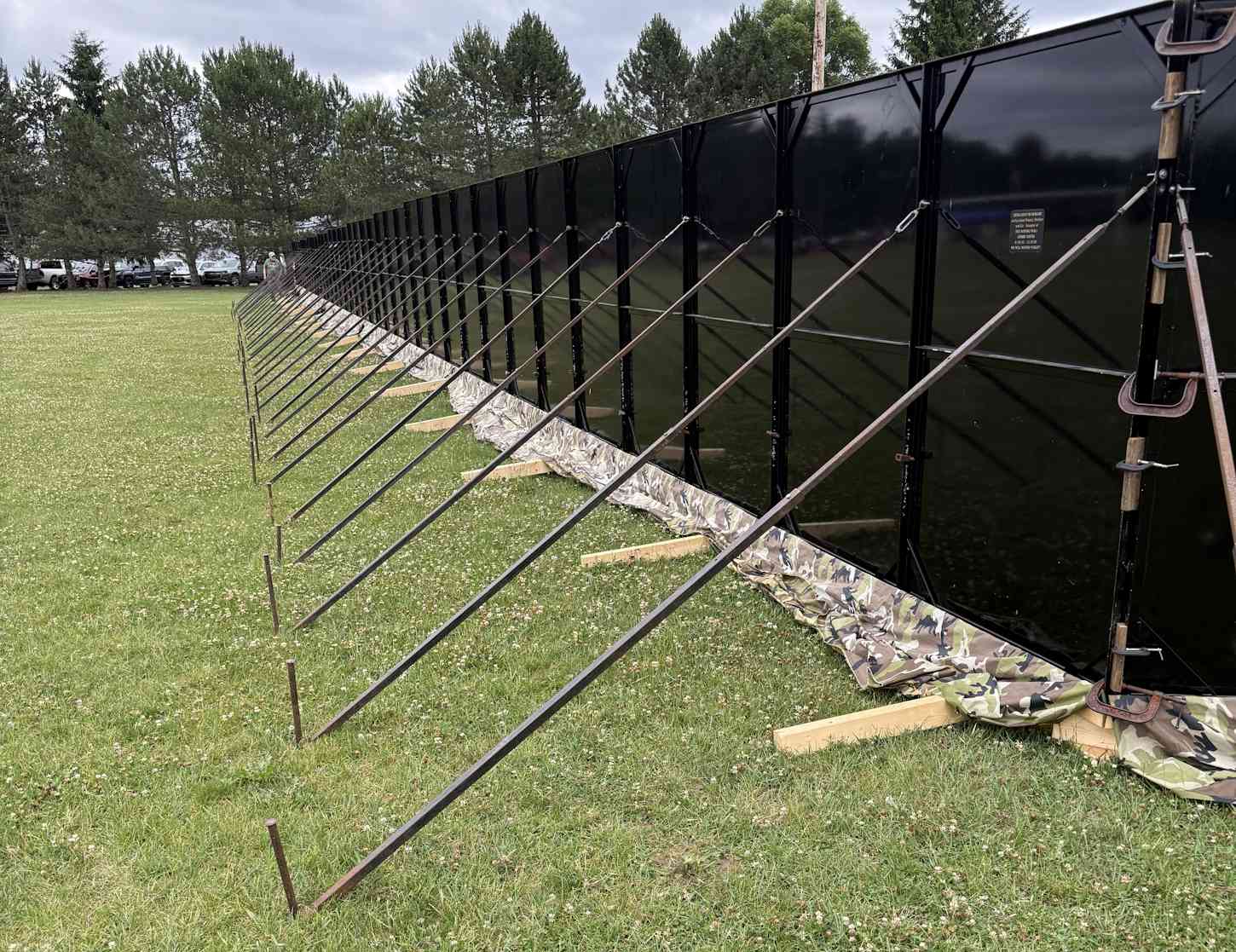
How the wall is installed along the foundation and supported to maintain its image.
Information Tables
Information tables should be set up on what will be the main path from the parking area to The Moving Wall™. If it is necessary to have the tables inside a tent, they should be placed close to the pathways. You should not try to have people enter a closed tent for name information. The items that are permitted on the information tables are:
The Directory of Names:
- pads for writing down the name, panel number and line number. These are critical for visitor since the names are arranged by time of death, not alphabetically.
- name rubbing forms and crayons for the name rubbings. Many locations create their own with their logo, dates, etc.
You can also have a listing of the names from your area and surrounding counties or your state, and a brief question and answer sheet for easy volunteer reference in case someone asks a question and the volunteer doesn't know the answer.
There is finally a "Smartphone App" (Search in your Apps for "Find a Name Vietnam" to assist with finding names. It's very simple to use and many times only needs a last name to find the correct person.
A word of caution. Once you've confirmed the correct name in the computer, don't automatically go to the sub-page of that person. It displays the military image of the deceased. That could be quite a shock to an older family member - ask first, if you are trying to confirm the person. If you cannot find a name on the Smartphone App, be sure to take the time to look through the booklets provided by The Moving Wall driver. A name misspelling, a wrong town, county, etc. will cause the "computer" version to not find a name. Don't turn away anyone. Use the printed book to assist the visitor. Included names are only those that died in Vietnam though.
Keep boxes of Kleenex visible and easily accessible.
Literature or material promoting any organization or material that seeks contributions is not allowed on the information tables.
Communications
There needs to be a telephone or two-way radios on site for communications with the local emergency services in case they are needed. With the proliferation of cellular phones, this doesn't seem to be a problem.
Wheelchairs/Carts
Have at least two wheelchairs available at the information tent. A local hospital could donate them for the week. Golf carts may be used to shuttle the elderly and handicapped to and from the information tent but cannot approach The Moving Wall™. Many local golf cart vendors will provide a cart or 2 free for this occasion.
Cots
At least one cot should be available in the tent that can be used for emergencies and for volunteers to rest, if desired.
Restroom Facilities
If there are no buildings close by for public use of restrooms, portable chemical toilets will be needed.
Benches
Four to six benches may be placed about ten feet from The Moving Wall™. These are critical for older visitors to rest and or reflect. Local Vocational/Ag Schools are a great source to provide them for this event, built by the students.
SIGNS
Signs that read: "No Pets, No Food, No Smoking" and "Please Turn Off Cell Phones" should be posted in strategic areas around the site.
Road Signs, Billboards
Road signs are extremely important and often serve as the only means for some people to learn of The Moving Wall's™ display in your community. Several sponsors have made signs to direct people to the site. Other sponsors have received cooperation from their state's Department of Transportation who made standard highway signs and installed them on the Interstates. Surface street road signs should go up on the morning that The Moving Wall™ is assembled. If your area has company digital billboards, ask them to include your event details on their digital billboard. It's just a programing function.
Flagpole
Most sponsors have flown the American flag and the POW/MIA flag, as well as the state flag. Some sponsors have had professionally-made poles installed, while others have made their own that looked almost as good for much less. Flagpoles should be placed at least the height of the pole away from The Moving Wall™.
Sound System
A sound system should be used for ceremonies, reading of the names, etc., and the sound level should be appropriately adjusted for each event.
Lighting
The Moving Wall™ needs to be lit throughout the night for visitors as well as for security. The local power company could donate the labor and use of a free temporary line. In some areas, the National Guard has provided portable lights, and in other places, local electrical contractors have loaned and installed lighting fixtures. Fluorescent-type bulbs provide good lighting and no glare .
Maintenance and grounds keeping
Volunteers should be willing to keep the area free of litter, and can assist in cleaning The Moving Wall™ panels. Before wiping any of the panels, have the volunteers check with The Moving Wall™ driver. It is essential that nothing be done to the panels until given specific instructions. Only the cleaning supplies brought with The Moving Wall™ should be used on The Moving Wall™. If The Moving Wall™ gets wet from rain, dew, etc., let it air dry. Do not attempt to dry The Moving Wall™ with rags or towels.
Volunteers
In addition to committee members for media, supply, site preparations, etc., at least ten (10) volunteers will be needed for set up; two (2) volunteers for locating names; one (1) volunteer to walk The Moving Wall™ assisting visitors, and; two (2) security around the clock. Volunteers should read the front pages in the Directory of Names and have access to this handbook. A free software system, like "SignUpGenius" can be used to help schedule and ask for volunteers to sign up on. This helps assure you have enough volunteers 24/7. Many Veterans will volunteer to be present overnight. Ask Boy Scouts to help. Best if volunteers are wearing a fluorescent type vest to be easily pointed out and spotted while helping visitors find a particular panel.
Food for the Volunteers
Past sponsors have had the community provide free meals and beverages for the volunteers. Usually the food is donated after fraternal or civic organizations, and businesses, are asked if they would help support The Moving Wall™ project. Many large Company/Franchise restaurants will provide free lunches for volunteers and coffees in the mornings..
It is recommended that you appoint a Supply Officer who can be responsible for getting a team of people together to get word out before The Moving Wall™ arrives. The supply officer and his/her team should be responsible during the week for bringing in the food.
This is what really makes The Moving Wall™ a true community project: the spirit of sharing and giving.
Water / Coffee
Water and coffee should be provided in the tent for volunteers.
The Directory of Names
In order to assure that you have enough copies of the Directory of Names on hand in the event of large crowds, you may wish to order additional copies (see page 13). Vietnam Combat Veterans,, Ltd. Memorial Fund will send you two Directory of Names several months prior to The Moving Wall's arrival.
There is finally a "Smartphone App" (Search in your phone Apps for "Find a Name Vietnam" to assist with finding names. It's very simple to use and many times only needs a last name to find the correct person. If you cannot find a name on the Smartphone App, be sure to take the time to look through the booklet provided by The Moving Wall driver. A name misspelling, a wrong town, county, etc. will cause the "computer" version to not find a name. Don't turn away anyone. Use the printed book to assist the visitor. Included names are only those that died in Vietnam though.
As more people handle the books, the faster they begin to lose pages. It is recommended that your volunteers look up names for people in the directories. This will help to minimize the handling and facilitate the books lasting through the display period.
Inclement Weather
Walking on grass in heavy rain where drainage is poor quickly brings mud to the surface. Some sponsors have put small wood chips on the path. Others have built wooden walkways and others have gone so far as to pour asphalt or concrete walkways. Many who have done this had the materials and labor donated by local contractors.
If severe weather high winds or hail are imminent we will pull the panels and place them back in the crates. This will take about thirty minutes with a crew of eight. As time is not always available, it should be coordinated to have a barrier (trucks, buses) placed between The Moving Wall and the weather.
Artifacts Left at The Moving Wall™
Throughout the week, place letters, poems, photographs, etc. into plastic bags to help keep them dry. These items may be pinned to the cloth draping, never taped to The Moving Wall™. Candles should be placed in a container before being lit. Prior to disassembly, volunteers can collect and place in boxes all the non-perishable artifacts that are preserved by Vietnam Combat Veterans, Ltd.
Ceremonies
It is entirely up to the sponsor as to how many ceremonies to have during the display. Typically, an opening ceremony is held within the first couple of days. This is generally the one the local media will give good coverage to, and it will help get the word out that The Moving Wall™ has arrived. The ceremony usually lasts 45 minutes to an hour, during which welcoming remarks are made, introduction of speakers, acknowledgments of volunteers, and giving a brief history of The Moving Wall™. A lying of wreaths usually follows speakers, retiring of the Colors, and Taps.
Brochures / Programs
Most sponsors have printed up brochures, or programs, which are handed out to visitors throughout the display. The format and general information to include are up to the sponsor. Usually, the front page, or cover, should state the dates and the location of The Moving Wall™ display. The following pages usually go on to list dates and times of any ceremonies. These pages are also used to give information and history about The Moving Wall™. The closing page is where most sponsors have thanked and/or listed those who were instrumental in bringing The Moving Wall™ through their donations of time, services, and money. Adding our web site www.TheMovingWall.org helps answer many questions.
Because printing costs can sometimes be high, some sponsors have used the brochure as a program for their opening ceremony, with the interior information listing times and speakers at the event. These programs were handed out throughout the display, even though they only covered the opening ceremony.
Example of a Trifold Brochure Handout
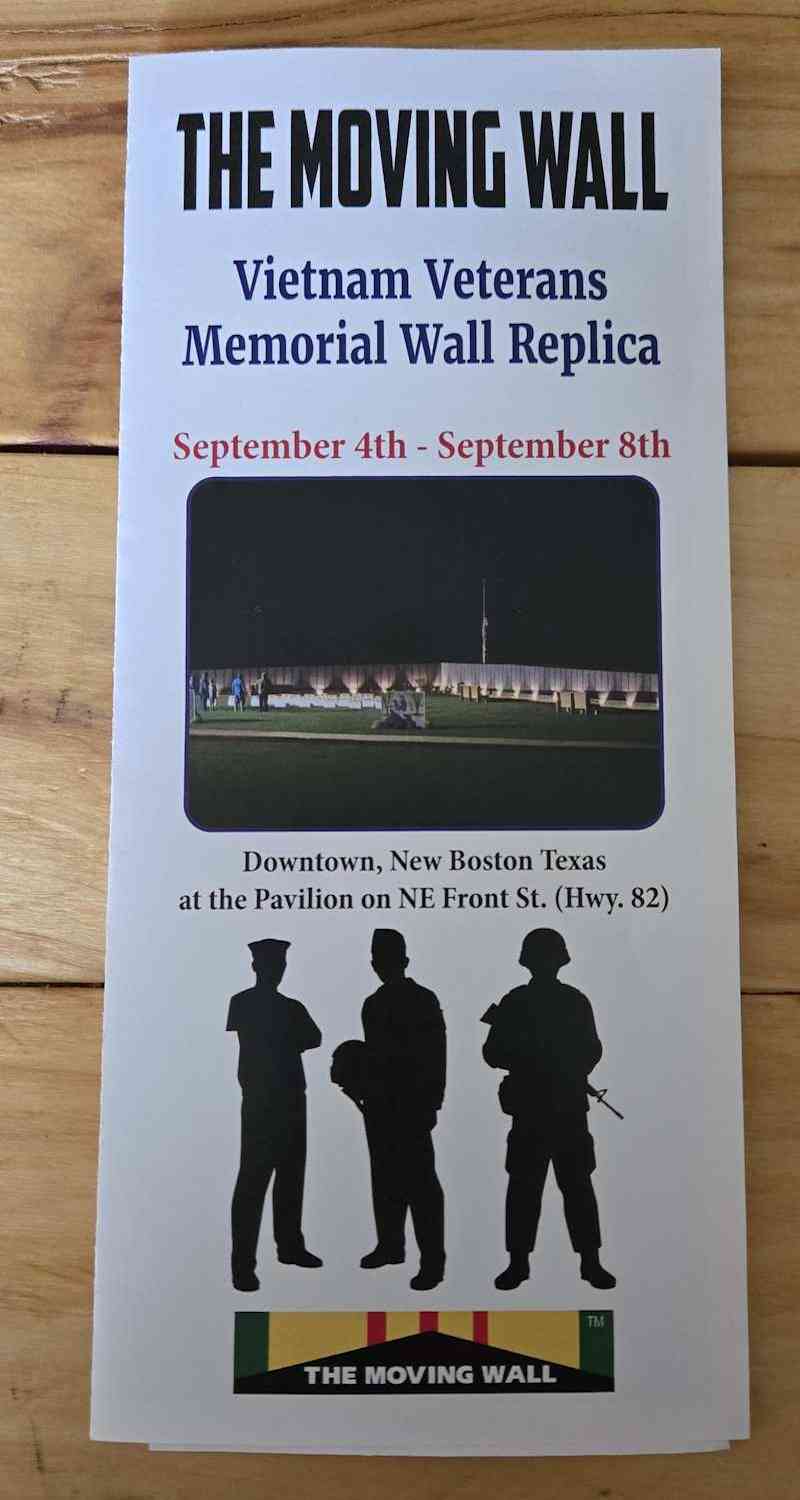
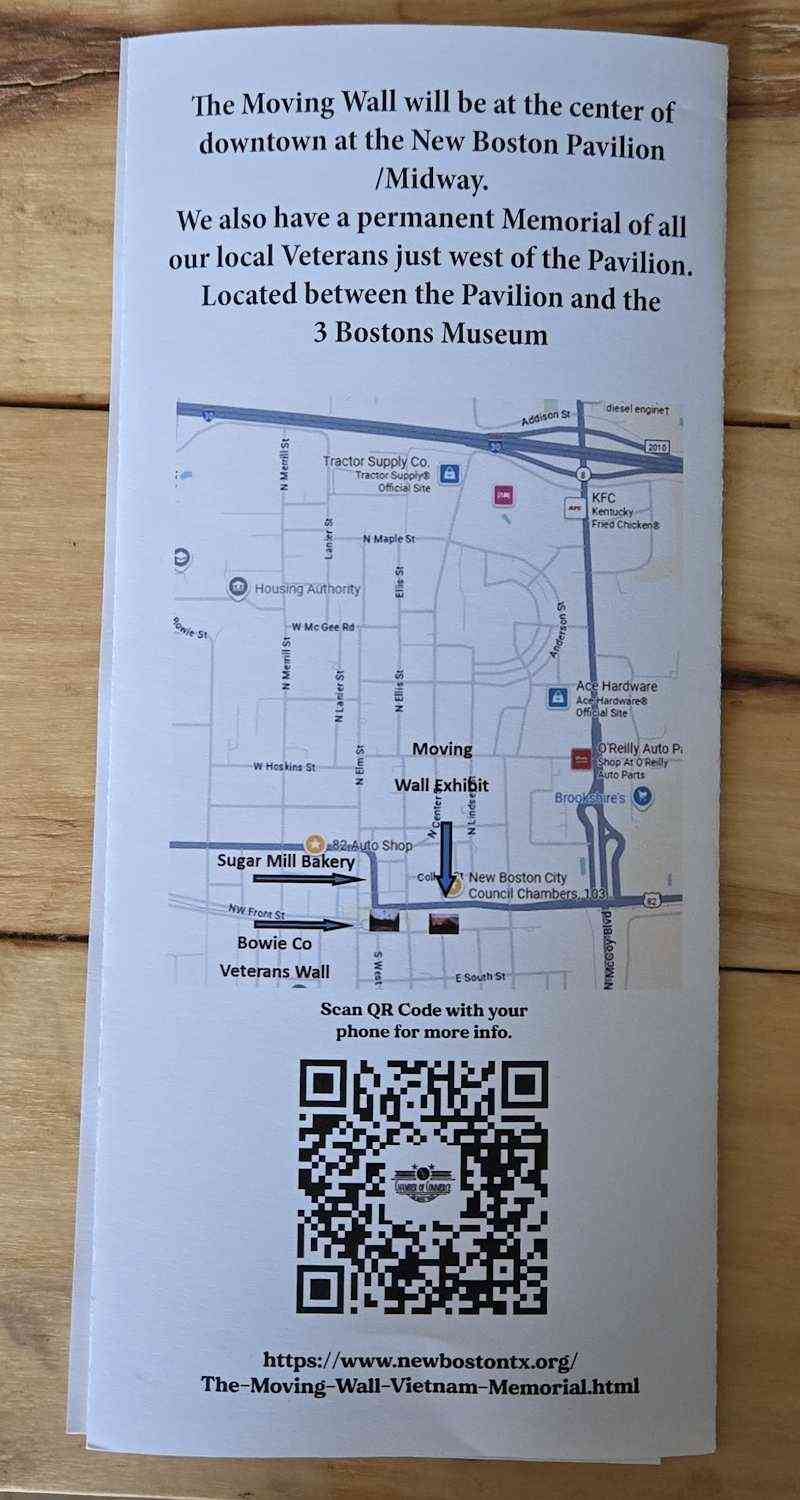
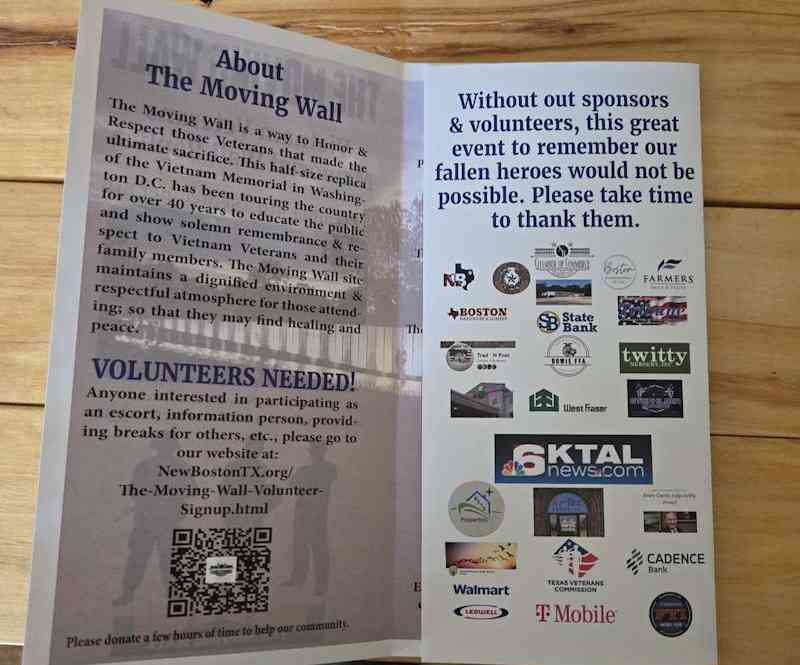
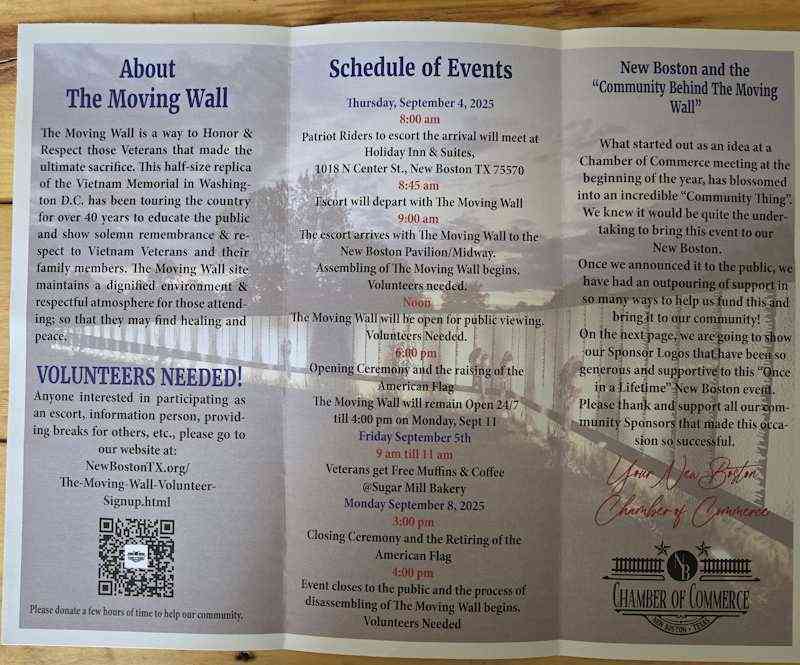
Schools
When arrangements are made to have schools visit The Moving Wall™, arrival of the buses should be staggered so the group is manageable, and they should be told what they are going to see and what their proper behavior should be prior to going to The Moving Wall™.
Escorts
Anyone wishing to escort The Moving Wall™ may only do so from the motel at which the drivers are staying to the display site, and only on the day of set up.
Vendors
Vendors are not encouraged, and are not permitted within 100 yards of The Moving Wall™ site or the entrance thereto.
II. QUESTIONS AND ANSWERS
Who formed the concept of the Vietnam Veterans Memorial in Washington, DC?
The idea of a national Vietnam Veterans Memorial began when Dr. Victor Westphall of Angel Fire, NM began constructing a memorial in Angel Fire in memory of his son and those who died with him. The idea of having a Vietnam veterans memorial located in the Nation's capital was that of Jan Scruggs. The Vietnam Veterans Memorial Fund, Inc. was incorporated on April 27, 1979 in Washington, DC by a group of Vietnam veterans: Jan Scruggs, President of VVMF; Robert Doubek, Project Director and later as Executive Director; John Wheeler, Chairman of the Board. They lobbied Congress for a two-acre plot of land in Constitution Gardens. Significant initial support came from Senator Charles Mathias, Jr. of Maryland and Senator John Warner of Virginia.
On July 1, 1980, President Jimmy Carter signed the legislation to provide a site in Constitution Gardens near the Lincoln Memorial. It was a three and a half year task to build the Memorial and to orchestrate a celebration, under the direction of Sandie Fauriol, to salute those who served in Vietnam. The Memorial wall was designed by Maya Ying Lin and was dedicated on November 13, 1982. The sculpture created by Frederick Hart called "The Three Servicemen" was unveiled on November 8, 1984, at which time control of the Vietnam Veterans Memorial was turned over to the National Park Service. In 1986, Vietnam veteran nurse Diane Evans began the task of adding a statue to the site, recognizing the women who served in Vietnam. The statue, sculpted by Glenna Goodacre, was dedicated on November 11, 1993.
Who conceived the idea of The Moving Wall™?
The concept and actual building The Moving Wall™ grew out of the hard work and effort by John Devitt, Gerry Haver and Norris Shears, Vietnam veterans from California, concerned with what they might possibly do to somehow "keep alive" and share the power and good that Devitt had experienced while attending the dedication of the Vietnam Veterans Memorial in Washington, DC. At first, it was decided to build a replica and display it on the West Coast, so that people who lived so far from the Capital might have a chance to experience the Wall. While in Washington, DC in February 1983, John Devitt was explaining his project to several other veterans he had just met. One exclaimed, "What a great idea! Is this going to be portable?" Trying to avoid any negatives around his project, John simply nodded and replied, "Yeah, it's going to be portable."
What is the official name of this portable Wall?
Originally, John Devitt simply called it the Vietnam Veterans Memorial (Mobile), drawing on his own background as a helicopter crew chief in the First Cavalry Division (Airmobile). In February 1985, while the Wall was on display at the State of California Veterans Home in Yountville, California, the name Micki Voisard of St. Helena, California dubbed “The Moving Wall™.” She is a member of Vietnam Combat Veterans, Ltd., and is a former flight attendant with Flying Tigers Airline. The Moving Wall™ has also been referred to as "The Traveling Wall,” the "Half-Scale Replica Wall,” and "The Healing Wall." However, its official name is The Moving Wall™.
When did construction of The Moving Wall™ begin?
Construction began in February 1983 after experimenting with various methods of replicating the Vietnam Veterans Memorial in Washington, DC. Out of several methods tried, Devitt decided silk-screening was the best way to replicate the names, making each name as legible as it is on the Memorial in Washington. John Devitt, Gerry Haver, and Norris Shears did the actual construction and silk-screening of names. When they began, John was confident they could complete the project in two weeks.
When was The Moving Wall™ completed?
The Moving Wall™ was completed in October 1984, having taken nearly two years rather than the two weeks John had hoped for. On October 11th, 1984, the last panel was silk-screened, mounted on its frame while the ink was still wet, and loaded into its crate. On October 15th, The Moving Wall™ was erected for the first time in Tyler, Texas. Carl McClung, a Vietnam veteran in Tyler, had heard about The Moving Wall™ seven months before and had contacted Devitt to see about scheduling a date. The display in Tyler, Texas coincided with the East Texas Rose Festival.
Who paid for The Moving Wall™?
The Moving Wall™ was paid for, like the Vietnam Veterans Memorial in Washington, from contributions made by the public.
To get the project started immediately, John Devitt and Gerry Haver pooled their own personal funds, which totaled barely over $2,500. Under normal circumstances, it would not have been enough cash to begin a project of this magnitude with any hopes of success. However, John was convinced this was not a "normal" project.
With a lot of leg-work, John and Gerry found several trusting and supportive individuals and companies who helped out by granting these two strangers credit based on their presentation and promise to make good on any debts, even if they had to pay on their own in the end.
THE STATISTICS
What are the dates 1959 and 1975 on the Wall?
1959 is the year, which the Department of Defense gave as the date in which the first American casualties occurred. The first two men listed, Dale R. Buis and Chester N. Ovnard (this name was a misspelling, it should have read Chester A Ovnand), were military advisors, killed on July 8th in Bien Hoa while watching a movie in a mess tent. However, after the dedication of the Memorial in November 1982, it was learned that a Captain Harry Cramer had been killed in action in 1957.
His name was subsequently added to the Memorial, but it was impossible to change the 1959 date on the granite panel. In 2000, Richard Fitzgibbon, Jr. who had been killed in 1956 had his name inscribed on the Wall.
1975 was the year the last 18 casualties occurred. The 18 were casualties on May 15th during the operation to rescue the U.S. freighter Mayaguez and its crew.
What are the dimensions of The Moving Wall™?
Overall length of The Moving Wall™ is 252.83 feet, which is slightly longer than half the length of the Memorial in Washington, DC. whose length is 493.5 feet. Composed of 74 separate frames, seventy frames contain two silk-screened panels. Each of the two walls that make up the entire Wall is 126.5 feet in length. The tallest panels have 137 lines of names, while the shortest panels at each end of the Wall have only one line. Originally, there were five names on each line, but with the addition of names, some lines now have six names. At the vertex of The Moving Wall™, where the two walls join at an angle, the panels are six feet in height. In Washington, D.C., these same panels are 10.2 feet in height.
Which wall is East, which is West?
When facing The Moving Wall™, the East wall is always to your right, starting with panel 1E (the panel with 1959 at the top, no panel number at the bottom). The West wall, starting with panel 1W (the panel with 1975 at the bottom) is just to the left of panel 1E.
What are the numbers at the bottoms of the panels?
The numbers at the bottom identifying each panel are used in locating a name and are merely reference numbers. They do not signify dates. The numbered for both East and West walls start out from the center, extending to the far ends with number 70E or 70W. The last two panels on each end are blank. These blank panels merely finish out the artistic design and are not locations for adding additional names.
What are the white dots?
The white dots are used to help locate the line on which a name appears, and are particularly helpful when looking for a name on the larger panels. Each dot marks 20 lines. They are located in the margin of each panel having more than 20 lines.
What are the symbols beside each name?
The diamonds (P) and pluses (C) indicate whether a person is confirmed dead (including those who died from accidents and natural causes), or those missing. The diamonds indicate that a person's death was confirmed. The pluses indicate that a person remains missing and/or held as a prisoner of war, and are in no way meant to be a religious symbol. A plus symbol can be turned into a diamond if a person is declared dead or their remains are recovered. A circle symbolizing the "Circle of Life" will be inscribed around a plus if a person is freed and brought home alive.
What is The Moving Wall™ made of?
The Moving Wall is made of aluminum panels, having a surface painted with a two-part polyurethane gloss black which gives a mirror-like finish, mounted to angular aluminum frames. The original structure was made of black Plexiglas panels mounted to plywood and lumber frames.
The original structure toured for almost three years before it was decided to replace the structure because of so much weathering. The aluminum structure is supported from the back by 76 steel square tubular braces.
How is the process done of putting the names on the panels?
After attempting several methods that proved unsatisfactory, John Devitt called the memorial fund in Washington, D.C. and told them that his various attempts had failed to produce the one thing John saw as crucial: clarity of the names. He informed them that silk-screening was near exact in replicating the "look,” but the cost of typesetting nearly 58,000 names was prohibitive. He asked to "borrow" the negatives that the original stencils for the Wall in Washington were made from. It was approved and the Cooper-Lecky Partnership, an architectural firm that supervised construction of the Memorial in Washington, loaned the stencils to John. The process John used for making the silk-screen stencils was similar to the process in making the stencils used in masking off the granite panels. All the construction and the silk-screening of all the names were actually done by John Devitt, Gerry Haver, and Norris Shears. Twenty seven years after the first panel was silk-screened, John continues to do the silk-screening whenever panels need to be replaced.
MISCELLANEOUS
What happens to the articles left at The Moving Wall™ by friends or relatives?
The artifacts, which people leave just as they have done in Washington, DC since the beginning, are collected, boxed, and marked at each location then taken back to White Pine, Michigan. They are currently stored in The Moving Wall’s™ warehouse/office complex. A museum will be built and all the artifacts that have been left at The Moving Wall™ will be displayed.
Who can I contact if I have any questions about The Moving Wall™ and its display schedules?
All questions concerning The Moving Wall can be addressed to:
Vietnam Combat Veterans, Ltd.
Attn: The Moving Wall
P.O. Box 715
White Pine, Michigan 49971
You can also get information via the Internet from The Moving Wall's web site at https://www.TheMovingWall.org or phone at (906) 885-5599 or by the Contact Us Form on the website.
Handbook of Information-2 - Page - Click HERE
Download This Page as a PDF